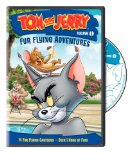In the 1930’s and 40’s MGM was trying to get in on the lucrative animation game. The field was dominated at the time by Warner Brothers with their Loony Tunes shorts, and of course, the iconic cast of animated characters coming out of the Walt Disney Studio. For years they had failed to find the right property to take advantage of the market. It wasn’t until the team of William Hanna and Joseph Barbera approached the studio with their first project that the times did change, at least a little, for the fledgling animation department at MGM. The project was far from an original one even for the time. It was a very basic cat-and-mouse adventure featuring a cat named Tom and a mouse named Jerry. There would be almost no dialog on the shorts. It certainly didn’t look like much of a hit to the studio brass, but with no better ideas on the way, they went ahead with the new shorts of Tom And Jerry. There’s a reason why the cat-and-mouse pair is such a classic. It’s because it works. If you can make your characters entertaining and endearing enough, you can have a hit. MGM finally entered the major leagues, and the team of Hanna and Barbera would become one of the most successful animation teams in history. They would go on to create such cherished characters as The Flintstones, Yogi Bear, The Jetsons, and, of course, Scooby Doo.
These were the days of the Golden Age in Hollywood. These shorts were not being produced for television, which hadn’t been invented when they began; rather, they were intended for theatergoers. In those days going to the movies was much more of an inclusive experience. You always got a cartoon short along with an adventure serial, the likes of Buck Rogers, Flash Gordon, and The Lone Ranger. These multi-chaptered serials were the forerunners to the modern television series. It kept you coming back to the movies to see what would happen next. Each chapter ended in a cliffhanger. These early serials were the inspiration for such film franchises as Star Wars and Indiana Jones. Finally you got one, sometimes two movies, all for the price of a single admission.
Then came television, and suddenly entertainment was available in your living room for the cost of a set. It hit the movie industry hard, and cutbacks had to be made. Over the span of a couple of decades the films eventually appeared alone. Serial and animation production was winding down. MGM was hit about as hard as any other studio, and before long Tom And Jerry were on their way out. But television did much to save the cat-and-mouse duo.
Collected here you’ll find 14 of Tom and Jerry’s best, providing over an hour of crazy antics.
Barbecue Brawl (1956): Tom and Jerry’s antics interfere with Spike teaching his son the fine art of cooking.
Springtime For Thomas (1958): The Easter Bunny leaves a surprise for Tom and Jerry. It’s an egg, but this one hatches into a little duckling.
Hic-cup Pup (1954): Tom and Jerry’s fighting wakes up Tyke and gives him a bad case of hiccups. So Spike warns the guys not to do it again. Guess what they do?
Little Quacker (1950): When Tom steals an egg for his breakfast, it’s a duckling that lands in the pot. That’s okay with Tom. He’ll have duck instead, that is if he can get the little quacker to cooperate.
Rock ‘n’ Rodent (1967): Jerry and his band are rocking all night long, and that means Jerry isn’t getting any sleep.
Neapolitan Mouse (1954): Tom and Jerry are in Naples where their cartoon fame gets them noticed by a friendly mouse and some not-so-friendly dogs.
Pet Peeve (1954): When pet food gets too expensive either Tom or Spike have to go. The one who can catch a mouse gets to stay.
Pup On A Picnic (1955): Spike and Tyke are trying to have a family picnic, but Jerry keeps hiding the food,and Tom’s chasing is driving the dogs crazy.
O-Solar-Meow (1967): The usual cat-and-mouse antics, but this time on a space station.
Robin Hoodwinked (1958): Jerry and his pals are out to rescue Robin Hood while Tom’s guarding the cell.
Guided Mouse-Ille (1967): It’s the far future, and Tom and Jerry now have robot versions of themselves to carry on their battle.
Timid Tabby (1957): Tom’s in trouble cuz George is in town and he’s afraid of mice. Can Tom keep Jerry captive and out of George’s sight?
The Vanishing Duck (1958): Jerry hides a duck from Tom with a jar of vanishing cream.
That’s My Mommy (1956): A newly hatched duck is in trouble when he mistakes Tom for its mommy. If Jerry can’t explain it to the duck, Tom’s going to have a nice dinner.
Video
Each episode is presented a 1.78:1 matted format. When you consider the age, you have to be pleased with these prints. There’s a great exhibition of color here. The animation lines are smooth, and the whole thing looks near perfect. There aren’t even that many print defects to distract you here. There is unevenness in contrast and brightness, but all in all these babies are in pretty fine condition.
Audio
The Dolby Digital 2.0 mono track offers pretty much dialog and music or effects. It’s fine for what it is.
Special Features
Nothing
Final Thoughts:
This is a brand new collection. Some of these cartoons have been released before. There seems to be a couple of common themes here. There’s a few hatching ducks and a couple where Tom and Jerry are somewhere else in time. I guess you can’t go wrong with these little collections, but when will Warner just give us all of them in one release? Or as the Italians say: “Che mouse fortissimo!”




